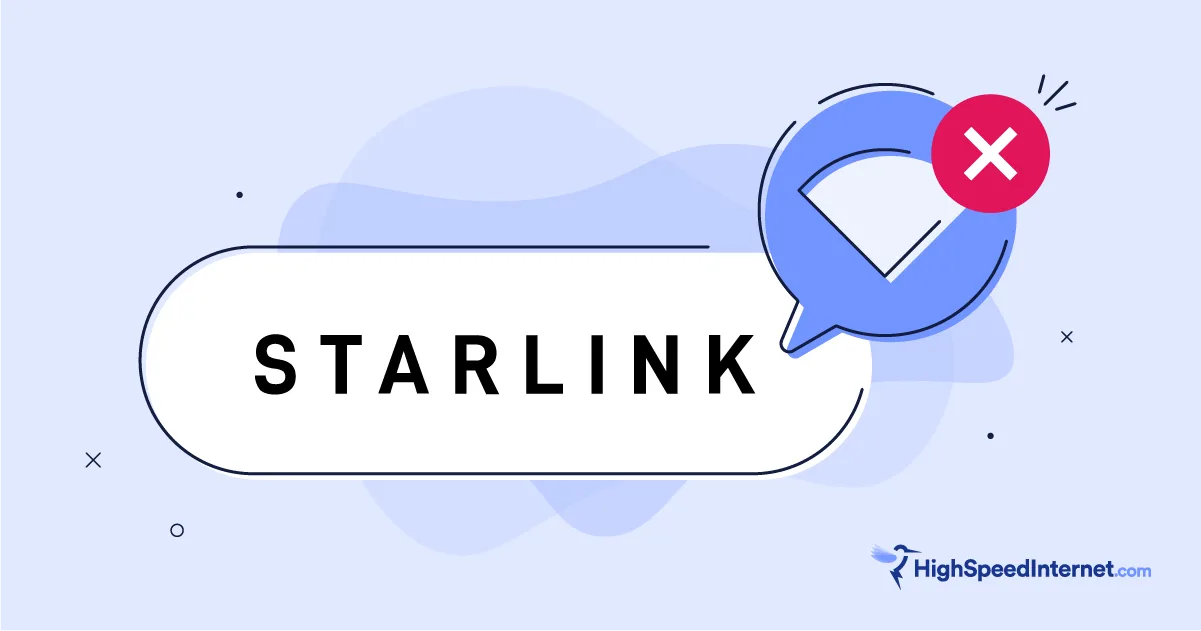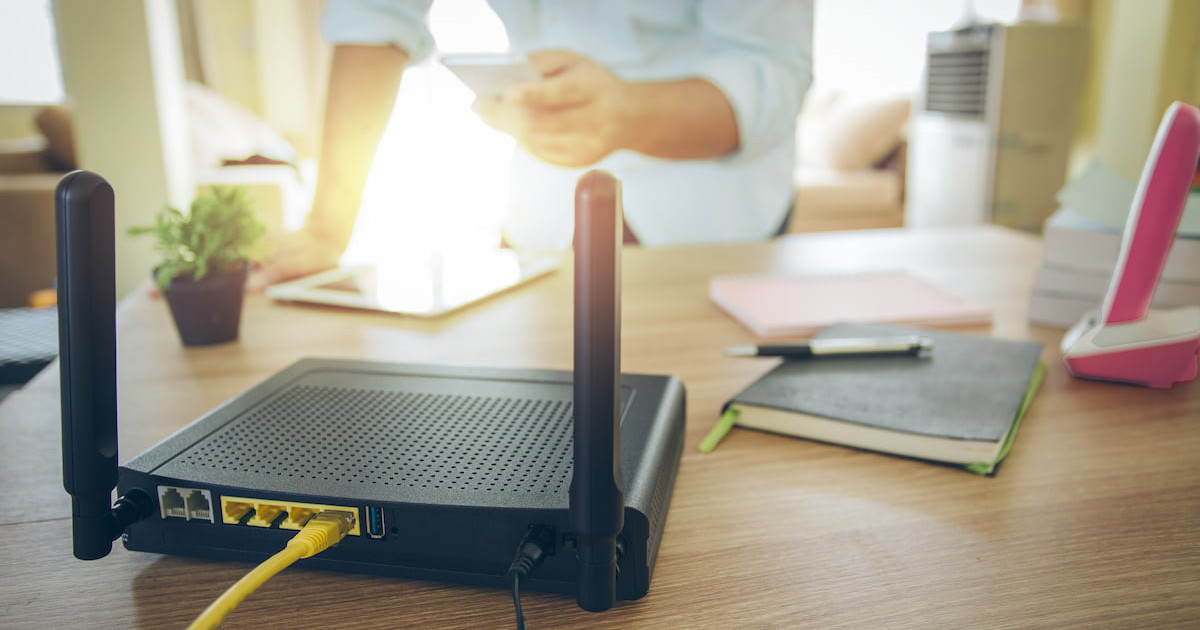Is Xfinity Internet Down?
Find out if it's a network outage or something you can control
Dec 11, 2025 | Share
Brand Guides, Equipment Guides, Internet Outage
Xfinity home internet is usually fast and reliable, but unexpected outages and slowdowns can really wreck your day. Sometimes you can fix your connectivity problem by checking your equipment, cables, and account.
If that doesn’t work, we’ll give you a few ways to check your network status. You’ll also find some outage statistics from real-world customers, hear what other customers have to say, and see how Xfinity compares to other internet providers. Then, we’ll cover what causes Xfinity outages and offer some insider info on recent upgrades to Xfinity tech.
Ready to try a new home internet service?
Enter your zip code to compare local providers.
On this page:
Troubleshooting tips | Xfinity outage stats | Refund information | Leave an Xfinity review | What other Xfinity customers say | Xfinity TV outages | Xfinity mobile outages | How Xfinity compares | Xfinity X-Class | Xfinity FAQ
On this page:
How to find out if Xfinity internet is down
The first sign your internet is down is a page or app not loading. You might get an error box, a spinning circle of death, or a smart speaker that says, “Sorry, your device is offline.”
When this happens, don’t panic. Instead, follow the steps below to troubleshoot and get back online as quickly as possible.
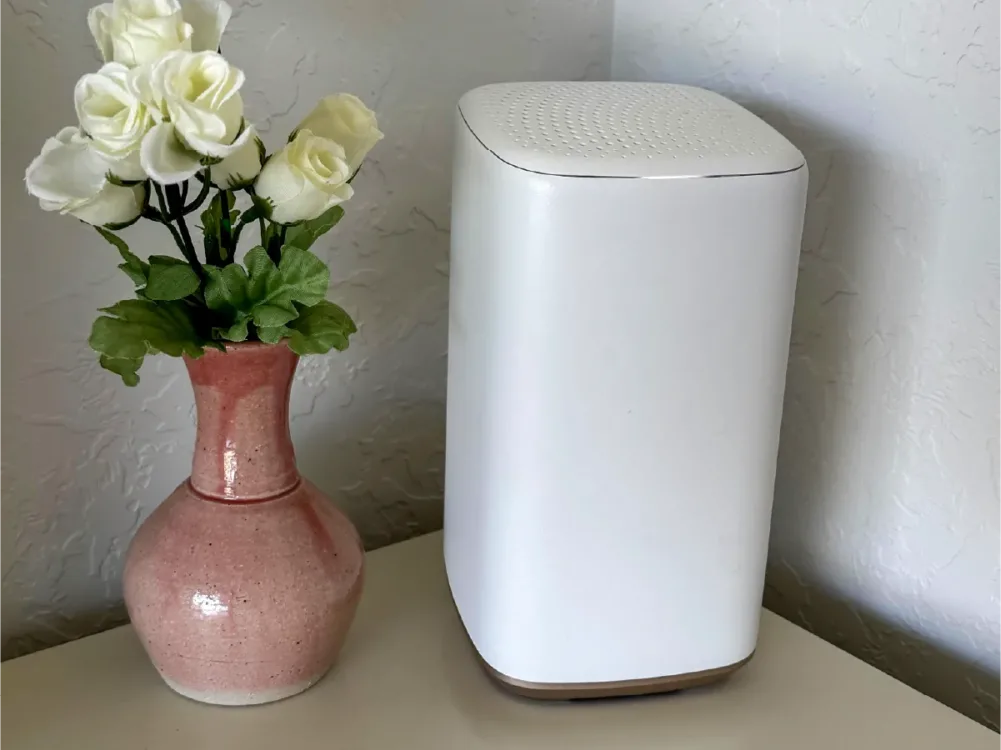
- Step 1: Check other sites, apps, browsers, or devices
- Step 2: Check the lights on your router and modem or gateway
- Step 3: Reboot or power cycle all your gear
- Step 4: Check the Xfinity app or Xfinity Status Center for reported outages
- Step 5: Check outside for work crews, or ask your neighbors if they have internet issues
Outage and reliability stats from real Xfinity customers
Xfinity doesn’t publish info about overall network uptime, but we know some neighborhoods have more outages than others. We figured out average downtimes by asking folks around the country how often outages occurred for them.
Customer data on Xfinity outages
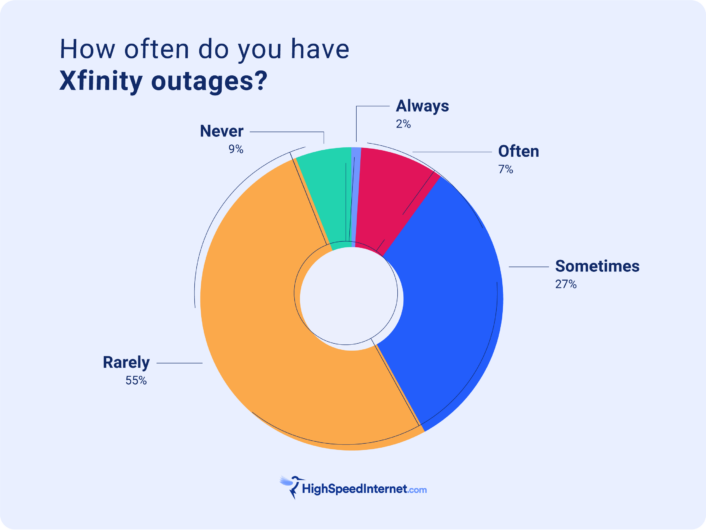
Customer data on Xfinity internet slowdowns
We also gleaned some data about real-world slowdowns. This metric is important for cable internet providers like Xfinity because they are more prone to congestion-related troubles. Here’s what we learned.
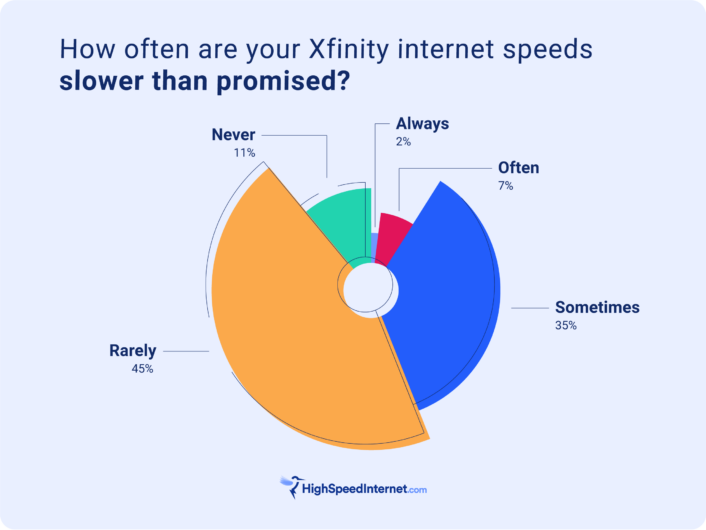
Learn more in our expert resource library
Sometimes there’s an easy fix when you can’t get online with your Xfinity connection, but that’s not always the case. Browse our resources below for expert help on all things Xfinity:
Can you get a refund for an Xfinity outage?
Xfinity does not provide refunds for weather-related home internet outages, but you may get a refund if the outage was due to something like network maintenance or a technical error caused by Xfinity personnel.
To find out if you’re due, pull up your bill by signing in to your account. You’ll see a “bill credits” section on page 3.
Since Xfinity provides service in dozens of states, the rules that apply to your account depend on where you live. This guide to Xfinity legal docs can help you find what applies in your situation.
Tell us what you think about your Xfinity service
If you’re an active Xfinity customer, we want to hear from you! Sharing your experience helps us improve our recommendations and helps other customers decide whether it’s time to switch internet providers.
What other Xfinity customers say
Xfinity used to have a less-than-stellar reputation for customer experience, but it seems to be improving. When we asked customers about their Xfinity service, responses were mixed. Most folks were happy with the service, many were pleased with its reliability, and almost all had good things to say about their internet speeds.
Among internet providers overall, Xfinity landed smack in the middle as a solid 7 out of 15. Xfinity scored higher than fellow cable internet giants Spectrum and Cox, but it scored lower than many of the most well-known fiber internet providers like Google Fiber and Verizon. It tied with fiber internet provider AT&T (one of its biggest competitors).
Xfinity customer survey scores*
| Provider | Overall Satisfaction | Speed | Price | Reliability | Customer Service |
|---|---|---|---|---|---|
|
| 3.9 | 4 | 3.5 | 3.9 | 3.7 |
| 3.9 | 3.9 | 3.7 | 3.8 | 3.8 | |

| 4.1 | 4 | 4.1 | 3.9 | 4.1 |
|
| 4.3 | 4.3 | 4 | 4.3 | 4.2 |
* Ratings based on a five-point system used in our Customer Satisfaction Survey. Higher is better.
In addition to asking customers to rate Xfinity, we asked them for their honest reviews of the service.
Xfinity customer feedback
“There have been a few outages of an hour or so.The other problem was a faulty cable the problem was resolved same day. All around the service has been good.”
“They could provide better speed and reliability. Often the internet will go out for no reason for up to 10–15 minutes. Other times it will become very slow.”
“Xfinity is very good at keeping our internet working. If there is an outage, they quickly repair it and get us back online.”
“Xfinity has failed to deliver in many ways. The service is very poor, with outages and slow speeds being the norm. In addition, customer service has been poor, with unhelpful troubleshooting that fails to resolve problems.”
Sourced from customers in all regions of the United States as part of the Customer Satisfaction Survey. We did not collect names or personal info.
Xfinity TV outages
If your Xfinity internet is down, your Xfinity TV will be down too. That’s because Xfinity internet and cable TV use the same technology. If you have just Xfinity TV, you can check for an outage using the same troubleshooting steps we listed above.
Different rules around cable TV outages apply in each state, but there’s good news for folks in Connecticut, Maine, and New York. If you lose your video service, you may be eligible for a prorated refund.
Xfinity mobile outages
Xfinity bundles its home internet and cable television service with mobile phone service. However, its mobile services use a different tech type to get you online. That means there’s a good chance you will still be able to connect via 4G LTE or even 5G if your home internet and TV are down.
If you can’t connect with your home internet, TV, or Xfinity mobile phone, your problem is most likely a billing issue. Call 1-800-Xfinity or find an Xfinity store near you for help.
How Xfinity compares
Xfinity is the largest cable internet provider in the US, reaching more than a third of all homes and businesses in the country. That means it competes with many different internet providers. What’s available to you depends on where you live.
AT&T vs. Xfinity
You might get a choice between fiber internet from AT&T and cable internet from Xfinity in some of the nation’s biggest cities, including San Francisco, Houston, Miami, Memphis, Nashville, Atlanta, and Jacksonville, Florida. AT&T offers faster speeds and unlimited data, but we like Xfinity’s cheaper plans for small households.
CenturyLink vs. Xfinity
CenturyLink sells fiber internet under the Quantum Fiber name in some areas that overlap with Xfinity cable internet service areas, mainly in New Mexico, the Wasatch Front, Denver, Florida, and Minnesota. In rural areas, CenturyLink DSL is the more likely Xfinity alternative.
In almost all cases, we recommend Quantum Fiber over Xfinity and Xfinity over CenturyLink. Among the three options, monthly pricing for good-enough speeds is about even.
Verizon vs. Xfinity
Verizon Fios internet—the company’s fiber offering—is exclusive to states in the Northeast, including Pennsylvania, Maryland, Washington D.C., Virginia, Philadelphia, New Jersey, New York, and Massachusetts.
In some of those areas, Verizon Fios and Xfinity compete head-to-head. Xfinity is cheaper, but Fios is better if you can get it. We recommend taking advantage of Fios unless you are a light user (think just emails, streaming in HD and browsing) and you can get away with one of Xfinity’s cheapest plans.
Frontier vs. Xfinity
In most areas where Frontier competes with Xfinity, you’re looking at Frontier DSL versus Xfinity cable. If that’s your situation, Xfinity is more budget friendly, a lot faster, and more reliable—but Frontier has the perk of unlimited data. Xfinity will almost always be a better choice than DSL.
If you can get fiber internet from Frontier, you’re in luck! In that case, we would opt for Xfinity if you’re a light user, because prices are lower. If you have a big home or need fast upload speeds, though, go with Frontier.
Google Fiber vs. Xfinity
Google Fiber has a tiny footprint compared to Xfinity, but there’s some overlap in Utah, Georgia, Texas, and Missouri. GFiber beats Xfinity for better customer ratings, but it has no true budget options. That said, GFiber’s speed, reliability, and free equipment can’t be beat.
How Xfinity’s internet prices compare
| Provider | Customer rating* | Cheapest plan | Order online |
|---|---|---|---|
|
| 8 | $40/mo.† for 12 mos. | |
| 8.1 | $55.00/mo.‡ | ||
| 7.3 | $50.00/mo.§ | ||
|
| 8.3 | $49.99/mo.‖ | View Plans for Verizon Home Internet |
|
| 7.3 | $29.99/mo.# | |
|
| 9.3 | $70.00/mo.** | View Plans for Google Fiber |
Max download speeds listed apply to lowest-priced plans, but higher-priced plans may offer faster speeds.
* Ratings based on a 10-point system used in our 2024 Customer Satisfaction Survey. Higher is better. Plan availability varies by location.
See disclaimers.
Xfinity tech upgrades: X-Class and Storm-Ready WiFi
Xfinity is a massive cable internet provider, but it’s facing fierce competition from fiber-to-the-home options such as AT&T and 5G internet options like T-Mobile. To keep up, Xfinity is making some big changes on the back end. Customers will still have a coax cable from the street to their house, but tech behind the scenes is getting a major makeover.
If all goes as planned with the Xfinity X-Class rollout, customers may see short outages during neighborhood upgrades over the next few years. When it’s all done, though, they’ll benefit from multigigabit upload and download speeds that rival what fiber can offer. It will be a lot faster and more reliable than 5G, too.
Sign up for planned outage updates from Xfinity.
FAQ about Xfinity
Why does Xfinity keep having outages?
How long do Xfinity outages last?
How can I report an Xfinity outage?
Disclaimers
Xfinity
† For 12 months, no term contract. Restrictions apply. Autopay w/ stored bank account and paperless billing req’d. Taxes and fees extra and subj. to change. Reduced speeds after 30 GB of usage/line. Data thresholds may vary.
AT&T
‡ Price after $5/mo Autopay & Paperless bill discount (w/in 2 bills). Plus taxes & fees. Monthly State Cost Recovery Charge in TX, OH, NV applies. One time install chrg may apply. Ltd. avail/areas. Call or go to www.fiber.att.com to see if you qualify.
CenturyLink
§ Limited availability. Service and rate in select locations only. Paperless billing required. Taxes and fees apply.
Verizon
‖ Price per month with Auto Pay & without select 5G mobile plans. Fios plan prices include taxes & fees. Consumer data usage is subject to the usage restrictions set forth in Verizon’s terms of service; visit: https://www.verizon.com/support/customer-agreement/ for more information about 5G Home and LTE Home Internet or https://www.verizon.com/about/terms-conditions/verizon-customer-agreement for Fios internet.
Frontier
# w/ Auto Pay & Paperless Bill. Max wired speed 200/200 Mbps. Wi-Fi, actual & average speeds vary. One-time charges apply.
Google Fiber
** Plus taxes and fees. Upload/download speed and device streaming claims are based on maximum wired speeds. Actual Internet speeds are not guaranteed and may vary based on factors such as hardware and software limitations, latency, packet loss, etc.
Author - Chili Palmer
Chili Palmer covers home tech services, with a special focus on understanding what families need and how they can stay connected on a budget. She handles internet access and affordability, breaking news, mobile services, and consumer trends. Chili’s work as a writer, reporter, and editor has appeared in publications including Telecompetitor, Utah Business, Idaho Business Review, Benton Institute for Broadband & Society, and Switchful.com.
Editor - Jessica Brooksby
Jessica loves bringing her passion for the written word and her love of tech into one space at HighSpeedInternet.com. She works with the team’s writers to revise strong, user-focused content so every reader can find the tech that works for them. Jessica has a bachelor’s degree in English from Utah Valley University and seven years of creative and editorial experience. Outside of work, she spends her time gaming, reading, painting, and buying an excessive amount of Legend of Zelda merchandise.




